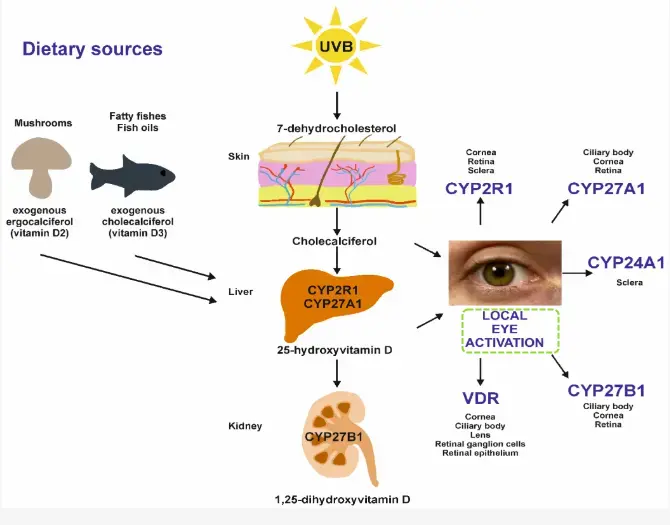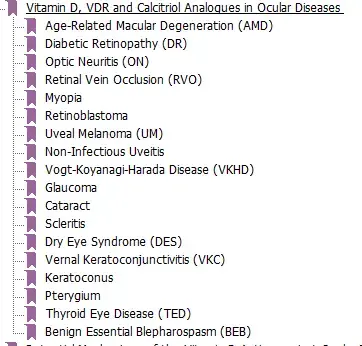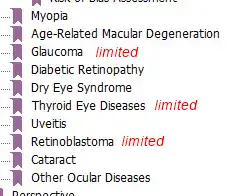Vision
Highlights of Vision in Vitamin D Life
12% larger pupils in children who are Vitamin D deficient – Feb 2024 parasympathetic nervous system?
Myopia, AMD, Dry Eye, and Diabetic Retinopathy are all associated with low Vitamin D - April 2023
An ocular disease can be associated with low vitamin D and 1 of 5 poor vitamin D genes – June 2022
Vitamin D treats and prevents a variety of eye problems (need 70 ng) – June 2018
Vitamin D and Myopia, AMD, Diabetic Retinopathy, Uveitis, Glaucoma, VDR etc. – May 2015
Tears often have 25 % higher levels of vitamin D than does blood
Vision problems having many studies on Vitamin D Life
Age-Related Macular Degeneration and Vitamin D - many studies
Diabetic Retinopathy associated with low Vitamin D - many studies
21+ studies of Myopia and Vitamin D
items in Vision category
Ocular Diseases and Vitamin D genes - June 2022
Vitamin D, the Vitamin D Receptor, Calcitriol Analogues and Their Link with Ocular Diseases
Nutrients 2022, 14(11), 2353; https://doi.org/10.3390/nu14112353
by Miłosz Caban andUrszula Lewandowska *ORCID Poland

Table of Contents

The global prevalence of eye diseases continues to grow, bringing with it a reduction in the activity levels and quality of life of patients, and partial or complete blindness if left untreated. As such, there is considerable interest in identifying more effective therapeutic options and preventive agents. One such agent is vitamin D, known to have a range of anti-cancer, anti-angiogenic, anti-inflammatory and anti-oxidative properties, and whose deficiency is linked to the pathogenesis of a range of cardiovascular, cancer, and inflammatory diseases. This review presents the current stage of knowledge concerning the link between vitamin D and its receptor and the occurrence of eye disease, as well as the influence of analogues of calcitriol, an active metabolite of vitamin D. Generally, patients affected by various ocular disorders have vitamin D deficiency. In addition, previous findings suggest that vitamin D modulates the course of eye diseases and may serve as a marker, and that its supplementation could mitigate some disorders. However, as these studies have some limitations, we recommend further randomized trials to clarify the link between vitamin D and its activity with eye disease.
📄 Download the PDF from Vitamin D Life
Vitamin D and Ocular Diseases: A Systematic Review - April 2022
Portion of the Table of Contents

Int. J. Mol. Sci. 2022, 23(8), 4226; https://doi.org/10.3390/ijms23084226
Hei-Nga Chan 1,†, Xiu-Juan Zhang 1,†, Xiang-Tian Ling 1, Christine Huyen-Trang Bui 1, Yu-Meng Wang 1,
Patrick Ip 2 , Wai-Kit Chu 1,3 , Li-Jia Chen 1,3,4 , Clement C. Tham 1,3,4,5,6 , Jason C. Yam 1,3,4,5,6,*
and Chi-Pui Pang 1,3,*
1 Department of Ophthalmology and Visual Sciences, The Chinese University of Hong Kong,
2 Department of Paediatrics and Adolescent Medicine, University of Hong Kong, Hong Kong, China;
3 Hong Kong Hub of Paediatric Excellence, The Chinese University of Hong Kong, Hong Kong, China
4 Department of Ophthalmology and Visual Sciences, Prince of Wales Hospital, Hong Kong, China
5 Department of Ophthalmology, Hong Kong Children’s Hospital, Hong Kong, China
6 Hong Kong Eye Hospital, Hong Kong, China
- Correspondence: [email protected] (J.C.Y.); [email protected] (C.-P.P.)
The contributory roles of vitamin D in ocular and visual health have long been discussed,
with numerous studies pointing to the adverse effects of vitamin D deficiency. In this paper, we
provide a systematic review of recent findings on the association between vitamin D and different
ocular diseases, including myopia, age-related macular degeneration (AMD), glaucoma, diabetic
retinopathy (DR), dry eye syndrome (DES), thyroid eye disease (TED), uveitis, retinoblastoma (RB),
cataract, and others, from epidemiological, clinical and basic studies, and briefly discuss vitamin D
metabolism in the eye. We searched two research databases for articles examining the association
between vitamin D deficiency and different ocular diseases.
One hundred and sixty-two studies were found.
There is evidence on the association between vitamin D and myopia, AMD, DR, and DES.
Overall, 17 out of 27 studies reported an association between vitamin D and AMD, while 48 out of
54 studies reported that vitamin D was associated with DR, and 25 out of 27 studies reported an
association between vitamin D and DES.
However, the available evidence for the association with other ocular diseases, such as glaucoma, TED, and RB, remains limited.
📄 Download the PDF from Vitamin D Life
Vision Meta-analyses
{category}
vision articles in Vitamin D Life
{category}
See also Vision on the web
- Association of vitamin C with the risk of age-related cataract: a meta-analysis March 2015
- 20% less likely to get cataracts with highest Vitamin C (intake and serum both considered)
- Vitamin D Deficiency Is Significantly More Common in People with Noninfectious Uveitis Oct 2016
- American Academy of Ophthalmology 2016 Annual Meeting
- 3X more likely to have Noninfectious Uveitis if vitamin D deficient
- Free software to determine your current eye glass prescription Aug 2018
- Uses your smartphone and your PC. Nothing about Vitamin D
Is Macular Degeneration Preventable? Mercola Dec 2018 - nothing about Vitamin D
- Japan has a 57X increase in AMD in 30 years suspect due to processed foods
30X more AMD in urban vs rural (processed vs no processed foods) Nigeria
- >1,000 X AMD rate after processed foods were consumed (Increase Omega-6, decrease Omega-3)
Safron improved AMD vision even for those taking AREDS RCT Jan 2019
- improved about 0.7 letters for those with mild to moderate AMD after 3 months
Consumer Labs summary on Vision Supplements - April 2019 (no mention of Vitamin D)
Lutein and zeaxanthin are believed to protect the macula of the eye (in the retina) from damage (see What It Does).
Many people consume relatively small amounts of lutein and zeaxanthin in their diets or have low levels of lutein in their blood; for them, taking a lutein supplement can slow the progression of age- related macular degeneration — although it won't improve the condition (see Getting lutein and zeaxanthin from food).
A dose of 10 mg of lutein appears to be better than a lower dose (6 mg). Higher dose products (e.g., 20 mg to 40 mg) are common, although it is not known if a higher dose is better. Nevertheless, 20 mg has been shown to be safe in a 6-month study.
It's not clear whether the "free" or "ester" form, or a natural or synthetic source, is better and it is not clear if there is added benefit with zeaxanthin.
Lutein and zeaxanthin at a reasonable dose (10 to 20 mg) can be obtained for as little about 15 cents per day (see What CL Found).
Other ingredients, particularly zinc, may be beneficial in slowing the progression of age-related macular degeneration. Vision formulas with these ingredients as well as lutein and zeaxanthin are available, although significantly more expensive than getting lutein/zeaxanthin alone. The formula with the strongest clinical evidence is Bausch + Lomb PreserVision AREDS Lutein (see What CL Found — Vision Formulas). One vision formula failed testing, containing only 9% of its listed lutein. To enhance absorption, it is best to take lutein and zeaxanthin supplements with a fatty meal. However, consumption of certain foods and supplements may decrease absorption of lutein and zeaxanthin (see Concerns and Cautions).
20+ Vitamin D Life pages with (MACULAR and DEGENERATION) AMD in title
This list is automatically updated
{LIST()}
Vitamin D Life - studies in both categories Vision and Infant-child
This list is automatically updated
{category}
